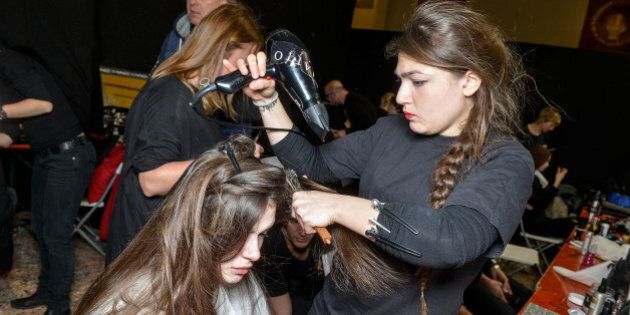
The Jetsons have a lot to answer for. Jane Jetson had a magical makeover machine which did her hair and makeup in a matter of seconds back in the early 60s, yet it's 2016 and we're still having to apply slap and style our hair ourselves.
Not cool.
So until we have robots to tszuj our stands into perfection, we asked hair stylists to dish on some common mistakes you may be making when it comes to styling our own hair and selecting cuts and colours. Tweak these and you'll be whipping your (perfect) hair back and forth in no time.
Blow drying at home
"Most women make the mistake of trying make it happen too fast and this is hindered by starting to blow dry when the hair is very wet," De Lorenzo guest artist Paula Hibbard told The Huffington Post Australia.
Instead, let your hair air dry naturally, at least partially, and start blow drying when air is damp as opposed to sopping.
"Another mistake is not using a heat protectant spray to prevent from damage," Hibbard said.
Anthony Nader, celebrity stylist and owner of RAW, has identified two other DIY drying issues.
"The first is using the blowdryer incorrectly. Blow drying without purpose can cause fine hair to go limp, and result in unruliness for coarse hair. Use the nozzle to smooth thick hair by sending the hot air downwards -- and for all over volume for thick hair types, blow the air against the natural downwards fall.
"The second is not blowdrying every strand thoroughly. When patches of hair are left damp, the humidity causes those areas to frizz as they dry and a professional looking finish will always be elusive," Nader said.
Choosing a hair cut
"Often clients choose a cut based on a celebrity they like. As much as we love to work with a reference, if a client with coarse, wavy, hair comes in wanting Lara Worthington's latest cut they won't be happy," Nader said.
"What makes her cut work is the way it offsets her bone structure, while the creamy highlights compliment skin tone. For best results, choose a cut based on a model or celebrity with similar hair and facial features to your own."
Hibbard agrees.
"It's important to go to a stylist you trust completely who will work with you to choose a style that not only suits you in terms of look, but your lifestyle in regards to how of then you wash it and how long you're willing to spend styling it."
Selecting a hair colour
"People tend to look at the trends and sat 'I want this', but they don't take into consideration their natural colour, the maintenance of the new desired colour, their skin tone and also what colours they have had in the past. Colouring over hair that has been affected previously by other colour makes hair look damaged and tacky," Hibbard said.
Nader advises that it is wise not to stray too far from your natural hue.
"Opting for two to three shades lighter or darker than your natural hair colour will always be the most flattering against your skin tone."
"Although, there are always exceptions to the rule. For example, someone with piercing blue eyes can often pull off a darker tone to make their eyes stand out, but to make it work they need to ensure eyebrows are also coloured for a seamless look," Nader said.

Kimmy K was able to go drastically lighter because shes a celebrity, and celebrities are exempt from the rules us mere mortals follow.
Washing
"Shampooing hair is such a personal thing, however if not done properly you won’t remove impurities and buildup from the environment and styling products," Hibbard said.
"I recommend to all my clients a good brush with a scalp brush before beginning, then shampooing twice concentrating on the scalp, then rinsing thoroughly. Condition with appropriate conditioner, leaving it in for a few minutes to allow absorption, before rinsing until the silky feeling is gone form the water.'
Nader points out that it comes down to the right shampoo and conditioner set for your hair type.
"Choosing the wrong shampoo can really make a difference when it comes to the end result of a particular style. If you have fine hair but use straightening or defrizzing shampoo, hair can become lank thanks to silicone build-up and/or heavy conditioners," Nader said.
"At the opposite end of the spectrum, women with very dry hair should avoid getting overly zealous with shampooing. Stick to one wash at the roots only to avoid brittle ends."
Using styling products
"People don't experiment enough!" Nader said.
"The difference between a disastrous product and a great one can often depend on the amount used. For best results, only apply a small amount to start with, and build each time. That way you can monitor how much was needed for a guaranteed winning style."
"Product is designed to make styling easier -- to hold, support and add texture or shine to the finished style, so don't be afraid of styling products, its there to make your hair look and feel better" Hibbard said.

Product is your friend.